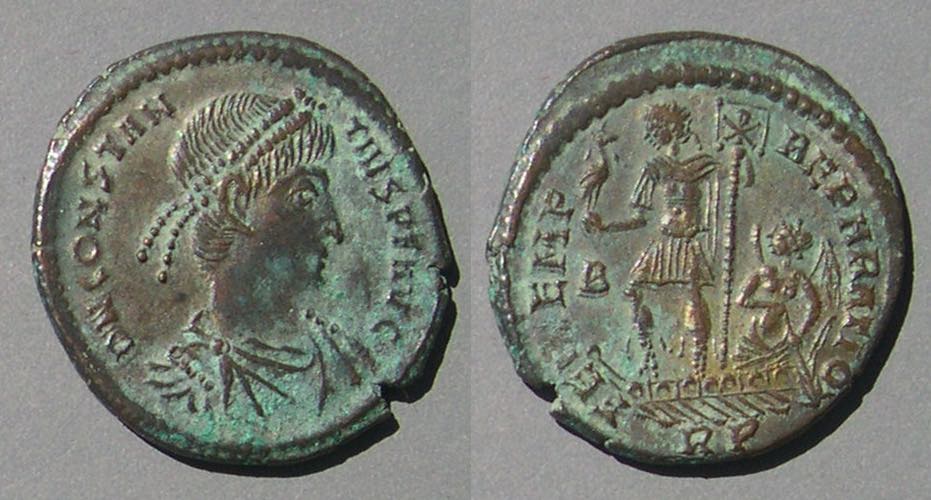 Bronze coins of Constantius II with legend
Bronze coins of Constantius II with legend
FEL TEMP REPARATIO, 348-361
(Go to the main type-set page.)
There are ten types (of course, the number depends upon where you draw the line):
(with numbers of examples noted in Bruck)
1) "fallen horseman" Large soldier spears small fallen horseman (coin to right)
("sitting or kneeling": Constantius II 86, Constans 13, Gallus 2)
("clutching": Constantius II 141, Constans 18, Gallus 62)
("reaching back AE2": Constantius II 267, Constans 0, Gallus 147)
("reaching back AE3": Constantius II 217, Constans 0, Gallus 47, Julian II 65)
2) "galley, AE2" Emperor on galley, holds phoenix or Victory, with Victory at the rudder
(holds phoenix: Constantius II 78, Constans 137, Gallus 3)
(holds Victory: Constantius II 52, Constans 50, Gallus 13, Magnentius 7 only at Trier)
3) "galley, AE3" Emperor on galley, holds Victory (Constantius II 89, Constans 40)
4) "hut" Emperor leads barbarian from hut underneath a tree (Constantius II 48, Constans 174)
5) "two captives" Emperor with two captives to left (Constantius II 168, from 9 mints; Constans 16, only from Siscia)
6) horseman rides down two foes (Only Rome. Constantius II 9; Constans 1)
7) "one captive" Emperor and one captive to left (Only Thessalonica. Constantius II, 9; Constans 2)
8) Phoenix on pyre (rocks) (Constantius II 67, Constans 43)
9) Phoenix on globe (Constantius II 27, Constans 25)
10) "M" Large "M" [This type is RIC VIII Rome 33 which is exceedingly rare and not available]
F409: Soldier spearing fallen horseman.

23 mm. 6.57 grams.
Mintmark ANB for Antioch.
"reaching back"
Lovely red patina

25-23 mm. 4.38 grams.
Mintmark ANЄ for Antioch.
"Reaching back"

23 mm. 5.07 grams.
Mintmark AQT•
for Aquileia
"clutching"
23 mm. 5.43 grams.
Mintmark TSE* for Thessalonica.
Unusual bust right holding globe.
"clutching"
23-22 mm. 4.77 grams.
Mintmark •ANH for Antioch.
"Reaching back"
Lovely black and tan patina, as often seen on coins of Antioch.
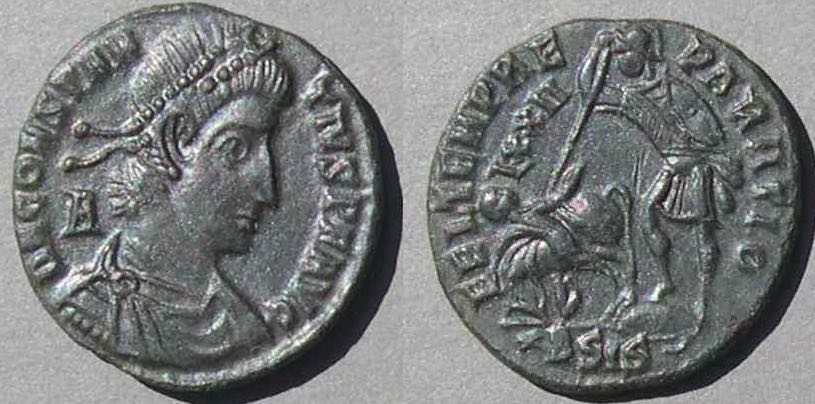
22 mm. 4.03 grams.
*BSIS* for Siscia.
"reaching back"
Variety with
LXXII in the field, for "72 to the pound".

21 mm. (Distinctly smaller) 3.77 grams.
R<wreath>Q for Rome.
"clutching"

19-17 mm. (Even smaller) 2.58 grams.
SCON for Arles named Constantina at the time.
"reaching back"

17 mm. (Even later and smaller) 2.33 grams.
ANBI for Antioch.
Struck 355-361.
 16-15.5 mm. 2.33 grams.
16-15.5 mm. 2.33 grams.
SMNB
RIC Nicomedia 104
 17 mm. 2.15 grams.
17 mm. 2.15 grams.
SMTSΓ
RIC Thessalonica 211
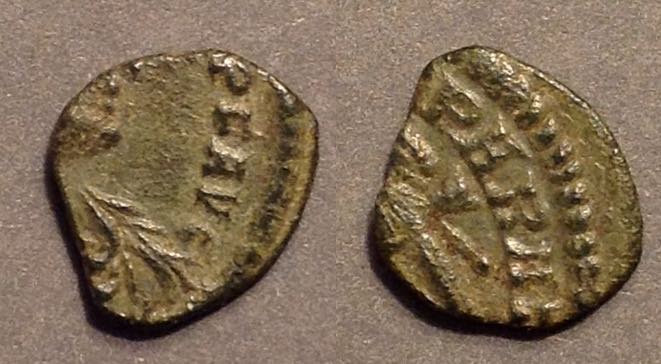 Very remarkable quartered coin--remarkable for being identifiable.
Very remarkable quartered coin--remarkable for being identifiable.
10 mm. Original perhaps 18 mm.
The right part of the bust of Constantius II
The right part of the soldier with legend ...PARAT....
Fond in England.

22-21 mm. 4.20 grams.
Unusual full-size imitation
Might be of Constans and possibly of Constantius II.
More "letters" in exergue than any regular mintmark.
The designs are crude but easily recognizable.
The lettering is not formed into words.
It seems to copy the "sitting" variety.
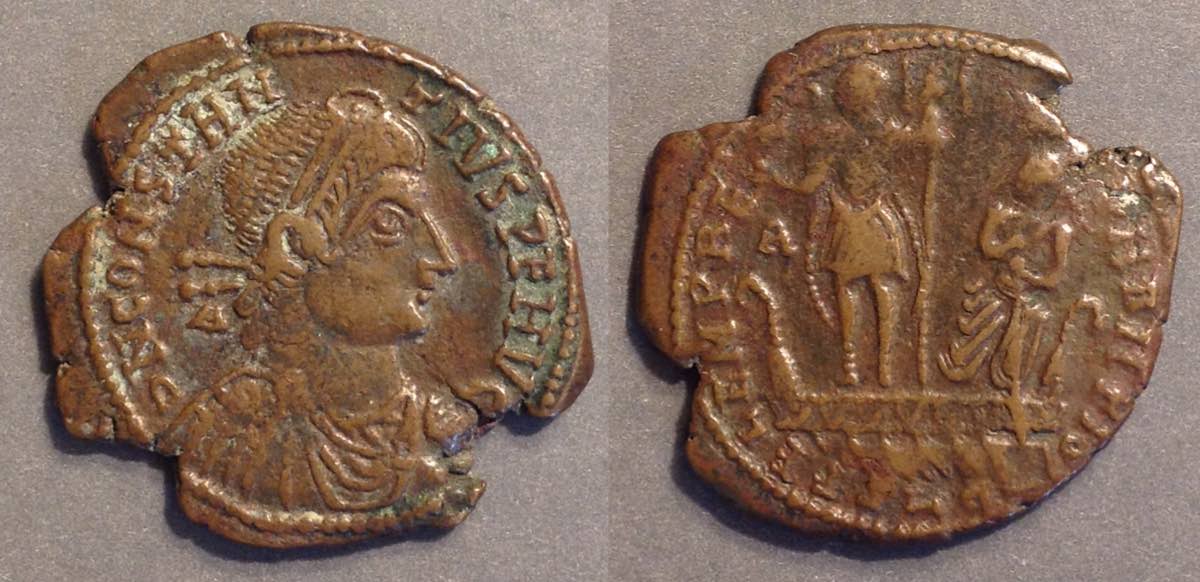
Ancient imitation
Full-size. ragged 25 mm. 5.39 grams.
Good obverse with slightly unusual portrait and correct legend, although the letter-sizes are not as even as usual.
FEL EMP RE-PARATIO ["T" missing]
SLC mintmark for Lugdunum.
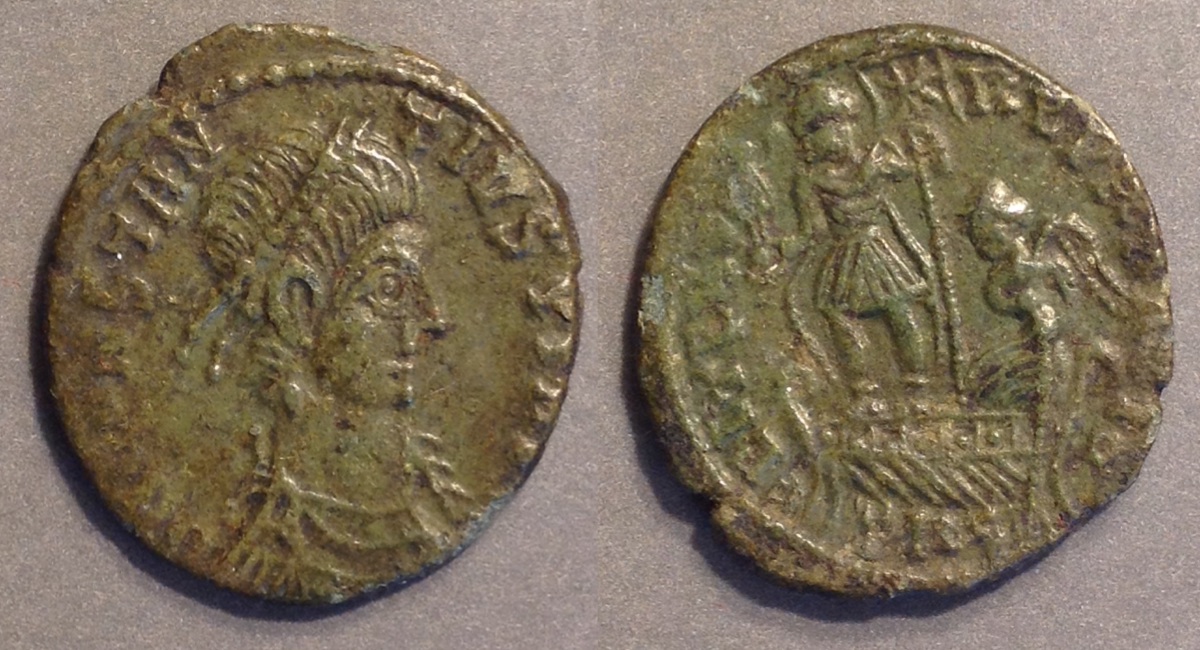
Ancient imitation
Full-size. 23-22 mm. 4.63 grams.
TRS mintmark for Trier.
This one if of the "holds Victory" variety.
There is nothing badly wrong with this example that screams "imitation." However, every element--portrait, lettering, position of the reverse figures--is a little crude. Together, they add up to the inference that this is an imitation.
F410: Hut. Constans was ruler in the west and the "hut" type is his, with lesser numbers issued in the name of Constantius II.

20 mm. 4.11 grams.
TRS for Trier.
Struck "348-350"
F411: "Two captives". Emperor standing left with standard, two captives kneeling or almost standing to the left. Various signs on the standard. The obverse of this type has the emperor facing left holding a globe in his right hand.
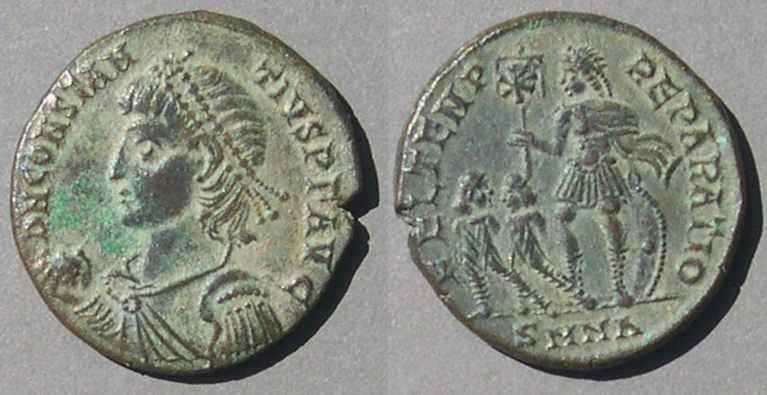
20 mm. 3.80 grams.
chi-rho on standard.
Captives almost standing.
Mintmark SMNA for Nicomedia.
The chi-rho is common on this type, but a clear one is desirable anyway.

22 mm. 4.81 grams.
Dark slate gray.
Captives kneeling.
SMKB for Cyzicus.
This one also has a chi-rho on the standard, but it less clear, which is a negative.

23 mm. 4.17 grams.
Silvered.
Mintmark SMKA for Cycicus.
Captive standing.
Chi-rho on standard.

20 mm. 4.10 grams.
Mintmark ANB for Antioch.
This one has the two captives kneeling and the standard has a cross-rho.

21 mm. 3.78 grams.
Mintmark ANE for Antioch.
Captines kneeling.
Cross on standard.
F412: Horseman rides down two foes. The obverse of this type has the emperor facing left holding a globe.
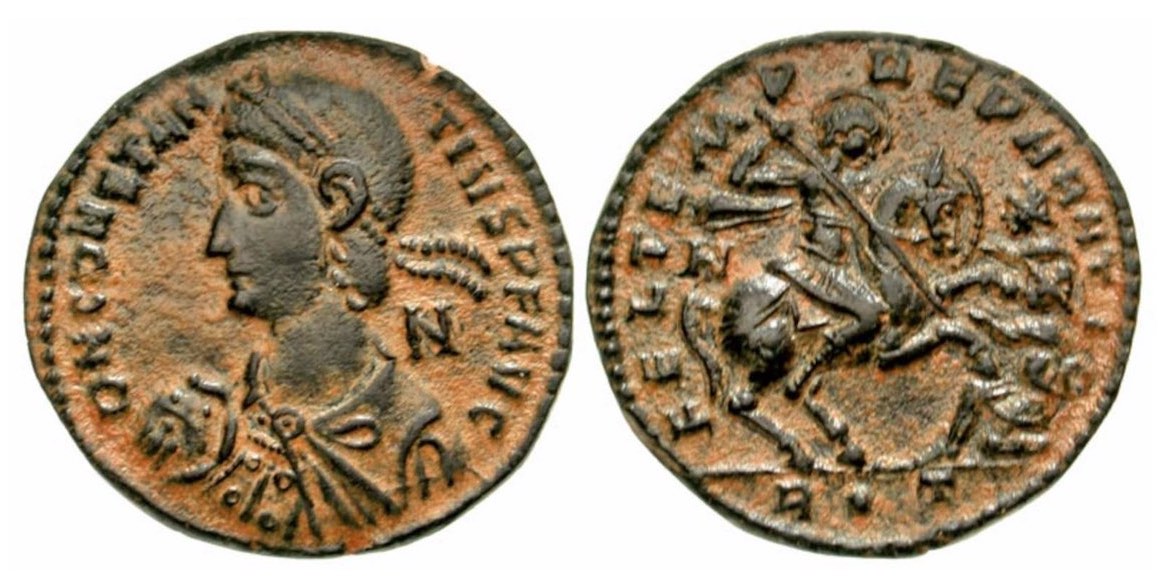
21-20 mm. 4.28 grams.
Mintmark R • T for Rome
This type is only from Rome.
Not counting the extremely rare "M" type (F465) this is the rarest and most expensive FTR type.

21 mm. 3.80 grams.
Mintmark R Є for Rome
"one captive" emperor and one captive to left.
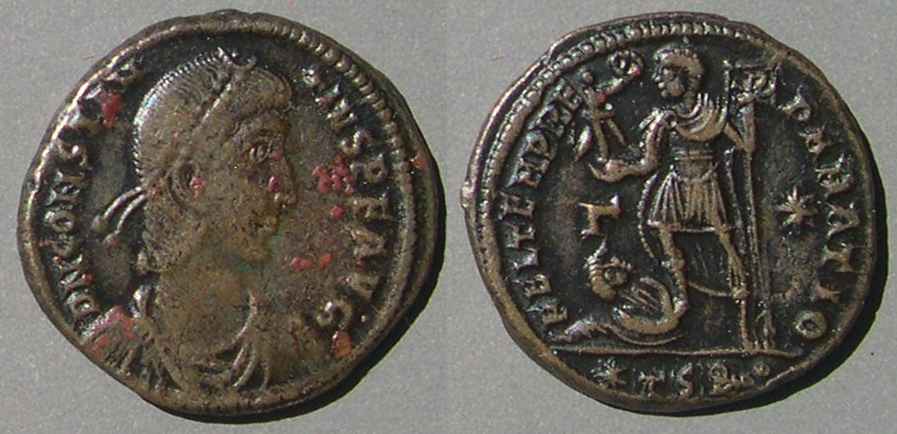
24 mm. 5.78 grams.
Emperor standing left holding Victory and standard with chi-rho, one captive at his feet left
Mintmark *TSB* for Thessalonica, the only mint for this type.
F413: "Phoenix on pyre" AE3
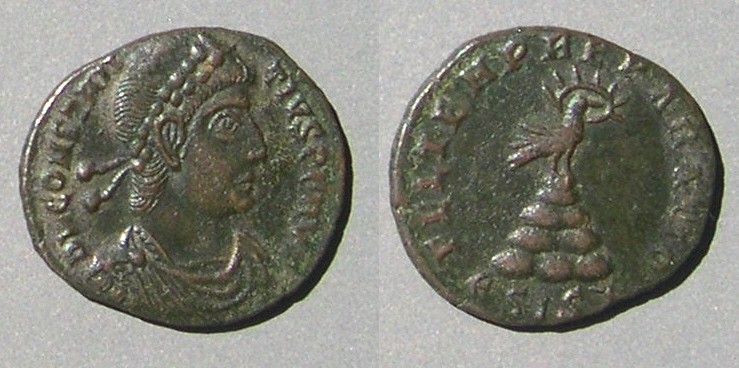
18-17 mm. 2.84 grams.
A half-denomination.
Phoenix, radiate, on a pyre
(which looks like a pile of rocks)
Mintmark ЄSIS for Siscia.
F413, FEL TEMP REPARATIO, phoenix on globe. Note for collectors: This type is common and sometimes considered to be merely a variety of the previous type.

FEL TEMP REPARATIO
Phoenix on globe.
This example. 17 mm. RIC VIII Antioch 130.
 Bronze coins of Constantius II with legend
Bronze coins of Constantius II with legend 



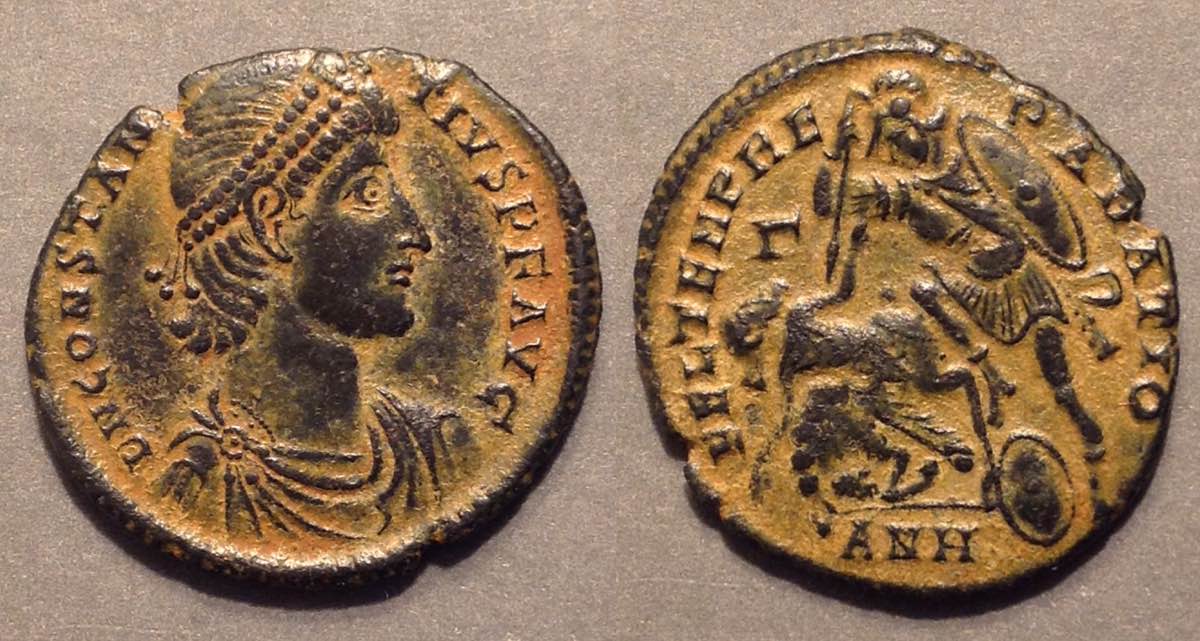





 17 mm. 2.15 grams.
17 mm. 2.15 grams.  Very remarkable quartered coin--remarkable for being identifiable.
Very remarkable quartered coin--remarkable for being identifiable.
